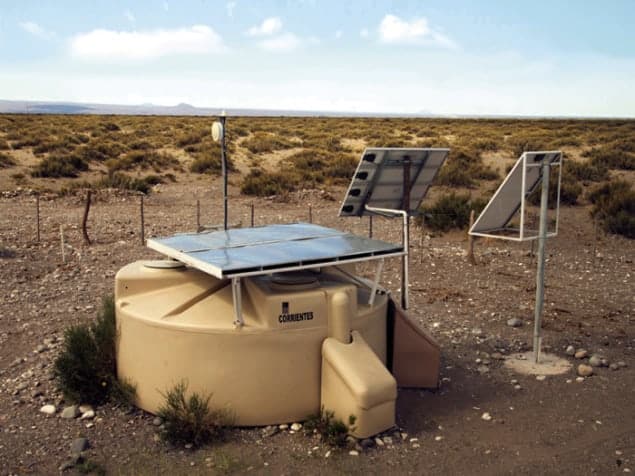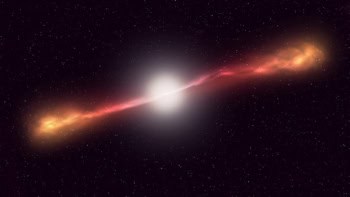
Significantly more muons appear to be created in cosmic-ray showers than are predicted by models based on data from the Large Hadron Collider (LHC) at CERN. That’s the conclusion of physicists at the Pierre Auger Observatory in Argentina, whose measurements agree with previous hints at a “muon excess” that first emerged more than 15 years ago. The muon excess could mean that the strong interaction is different at collision energies greater than those currently achieved at the LHC.
The Pierre Auger Observatory is an array of 1660 water-filled tanks spread out over an area of 3000 km2. It detects muons created from the decay of low-energy pions in the shower of particles created when a cosmic-ray proton interacts with the atmosphere. Most of these fast-moving muons survive the journey to the ground, where they can be spotted from the Cherenkov light they emit as they travel through the water in the tanks. Four telescopes are also used to spot the fluorescent light in the atmosphere created by the cascade.
Showers that are seen both in the Cherenkov detectors and the telescopes – known as “hybrid events – provide a wealth of information about how the showers occur. The telescope data provide a good measure of how much energy is deposited in a shower, whereas the Cherenkov data tells physicists about how hadrons (such as pions) are created in showers.
Avoiding electrons and positrons
Physicists on the Pierre Auger collaboration have used interaction data gleaned from proton–proton collisions at the LHC to predict how many muons, on average, should be produced by a shower of a given energy. While the cosmic-ray collisions of interest are about 10 times more energetic than LHC collisions, physicists have been able to use LHC data to create models that describe how the muons are produced in the shower, as well as how electrons and positrons are produced. Understanding electron and positron production is important because the Cherenkov detectors also detect these particles and cannot distinguish them from the muons of interest.
The detection rates of muons and electrons/positrons in the Cherenkov detector are a function of where in the sky the showers occur. Events that happen directly overhead a detector will be dominated by electrons and positrons, whereas those arriving from more than 37° from vertical will deposit more muons in the detector. The Pierre Auger data analysed in this latest study contain 411 hybrid events – collected over nine years – that span 0–60°. By looking at the numbers of muons and electrons/positrons detected as a function of shower energy and arrival angle, the team was able to test its LHC-inspired models.
While the numbers of electrons and positrons they detected agreed very well with their models, the muons were wide off the mark. They found that about 33% more muons were detected than predicted by the “EPOS-LHC” model and about 61% more were detected than predicted by the “QGSJet-II-04” model.
Firmer ground
This is not the first time an excess of muons has been spotted. In 2000, physicists working on the HiRes MIA array in Utah detected more muons than expected. Last year, a study of muons from showers nearly horizontal to Pierre Auger detectors also registered more muons than expected. However, this latest study puts the muon excess “on firmer ground”, according to Thomas Gaisser of the University of Delaware, because it involves both Cherenkov and telescope observations.
The research is described in Physical Review Letters, and writing in a commentary piece that accompanies the paper, Gaisser (who is not a member of the Pierre Auger team) highlights two possible explanations for the excess. One is that more collision energy than predicted by the models is going into the production of baryon–antibaryon pairs. The other possibility, according to Gaisser, is that the physics of the strong interaction is different at cosmic-ray collision energies than it is for LHC collisions. However, he points out that further measurements at the Pierre Auger Observatory will be needed to shed further light on the mysterious excess of muons.



